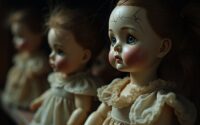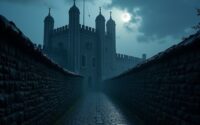Japanese Onryō: Vengeful Ghosts in Modern Japan
Japan’s vengeful spirits haven’t stayed buried in the past. They’ve clawed their way into smartphones, movie screens, and the darkest corners of Tokyo’s skyline. These onryō don’t just haunt—they evolve, adapting ancient grudges to modern anxieties. From Heian aristocrats who died in disgrace to contemporary urban legends, they reflect something deeper about Japanese society. What drives a culture to keep its ghosts so painfully alive?
Introduction

While Japan has transformed into one of the world’s most technologically advanced nations, the ancient figure of the onryō—a vengeful spirit born from intense suffering or wrongful death—continues to haunt the collective imagination of its people. These wrathful ghosts aren’t confined to dusty folklore collections or historical texts. They’ve adapted seamlessly to contemporary culture, appearing in blockbuster horror films, manga series, and urban legends that spread through social media. Today’s Japanese citizens encounter onryō references daily, from subway advertisements for horror movies to shrine ceremonies meant to appease restless spirits. This persistence reveals how traditional supernatural beliefs don’t simply vanish in modern societies. Instead, they evolve, finding new expressions that resonate with current anxieties while maintaining their core power to terrify and fascinate audiences across generations.
Ancient Heian Period Aristocratic Deaths
The most powerful onryō legends emerged from the Heian period (794-1185), when political intrigue and deadly court rivalries created perfect conditions for vengeful spirits. Sugawara no Michizane’s wrongful exile and death in 903 sparked Japan’s most famous supernatural revenge. After lightning struck the imperial palace and killed his political enemies, the terrified court deified him as Tenjin to appease his spirit.
Prince Sawara’s execution in 785 released another feared onryō. Plagues, earthquakes, and mysterious deaths plagued the capital until Emperor Kanmu relocated it from Nara to Kyoto. The aristocracy didn’t dismiss these spirits as superstition—they built shrines, performed rituals, and posthumously restored titles to pacify the dead. These responses weren’t just religious acts but political necessities that acknowledged how injustice could manifest as supernatural vengeance.
Notable Cases or Sightings

How do onryō manifest in contemporary Japan beyond ancient legends? Modern sightings often occur at sites of tragedy. Tokyo’s Sunshine 60 building, constructed over Sugamo Prison’s execution grounds, has generated numerous reports of ghostly encounters since the 1970s. Employees’ve described sudden temperature drops and glimpsing shadowy figures in empty corridors.
The 1995 Aokigahara forest became associated with yurei manifestations after Japan’s economic bubble burst. Visitors report hearing disembodied voices and experiencing overwhelming dread near specific trees. Inunaki Village‘s abandoned tunnel attracts paranormal investigators who’ve documented unexplained electronic malfunctions and photographed mysterious mists.
Television programs like “Honto ni Atta Kowai Hanashi” regularly feature witness testimonies. A 2019 Osaka apartment complex reported synchronized nightmares among residents, linking them to a murder-suicide that occurred there decades earlier.
Common Theories or Explanations
When psychological trauma meets cultural belief systems, researchers propose that onryō manifestations stem from collective memory imprinted on specific locations. They’ve documented how tragic events create psychological templates that witnesses unconsciously project onto ambiguous stimuli. Sleep paralysis explains many encounters where victims report seeing vengeful spirits pressing on their chests.
Neuroscientists link onryō sightings to temporal lobe activity and electromagnetic field fluctuations at reportedly haunted sites. They’ve found infrasound frequencies below human hearing can trigger feelings of dread and peripheral hallucinations. Cultural anthropologists argue these apparitions serve as society’s way of processing unresolved justice and historical trauma. Modern stress amplifies susceptibility to perceiving supernatural threats, especially in locations with violent histories. Environmental factors like carbon monoxide leaks and mold toxins also produce experiences matching traditional onryō encounters.
Frequently Asked Questions
How Can Someone Protect Themselves From an Onryō’S Curse?
One can protect themselves from an onryō’s curse through Buddhist prayers, Shinto purification rituals, salt barriers, protective amulets called omamori, and by resolving the spirit’s grievance or performing proper burial rites for the deceased.
What Rituals Are Performed to Appease Vengeful Spirits in Japan?
Buddhist priests perform memorial services called *kuyo* while Shinto priests conduct purification rituals using salt, water, and prayers. They’ll build shrines, offer food and incense, and recite sutras to transform the spirit’s anger into peace.
How Do Onryō Differ From Other Types of Japanese Ghosts?
Onryō differ from other Japanese ghosts because they’re specifically vengeful spirits seeking retribution for wrongs suffered in life. While yūrei encompass all ghosts and some spirits like zashiki-warashi bring fortune, onryō exclusively harbor malevolent intentions.
Can Onryō Be Permanently Banished or Destroyed?
Traditional beliefs hold that onryō can’t be destroyed but can be pacified through proper rituals, prayers, and addressing their grievances. Buddhist priests perform ceremonies while Shinto purification rites help appease these spirits’ vengeful nature.
What Locations in Japan Are Most Associated With Onryō Activity?
Japan’s most notorious onryō locations include Aokigahara Forest, where suicide victims’ spirits roam, Inunaki Village’s abandoned ruins, Himeji Castle’s Okiku’s Well, and Tokyo’s Sunshine 60 building. These sites attract paranormal investigators and terrify locals.


